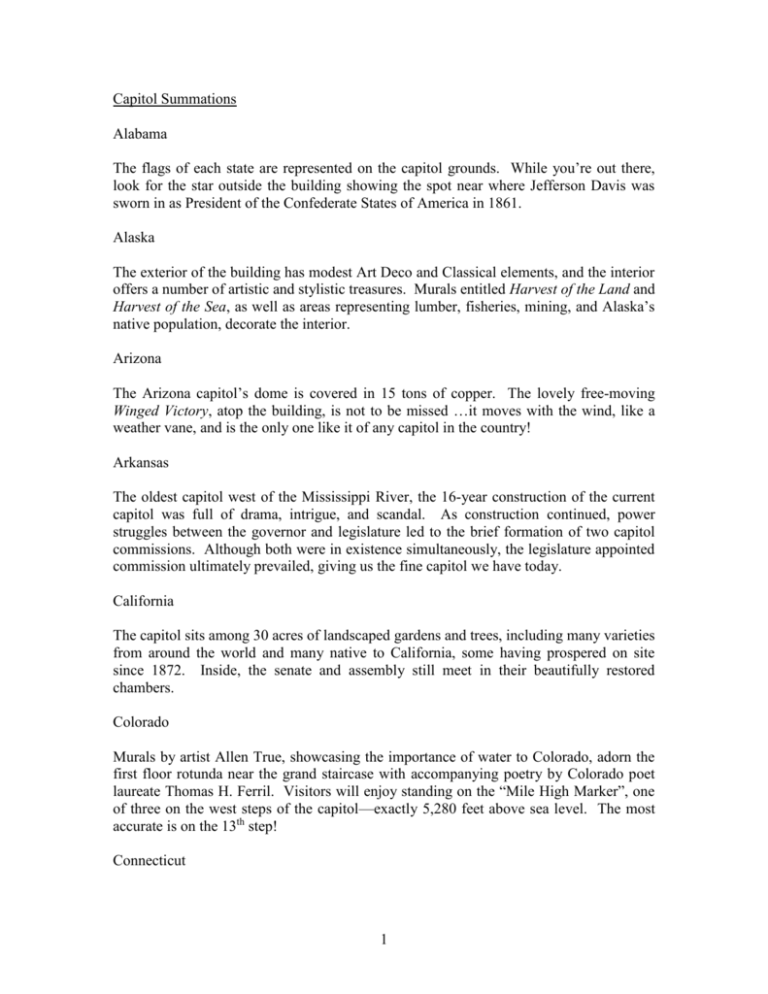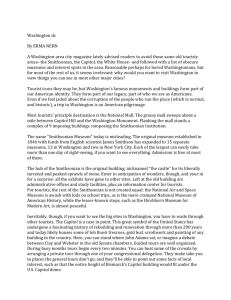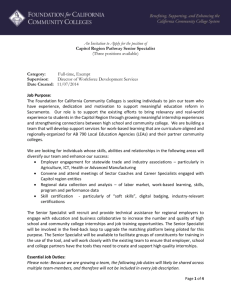Alabama - The Capitol Collection
advertisement

Capitol Summations Alabama The flags of each state are represented on the capitol grounds. While you’re out there, look for the star outside the building showing the spot near where Jefferson Davis was sworn in as President of the Confederate States of America in 1861. Alaska The exterior of the building has modest Art Deco and Classical elements, and the interior offers a number of artistic and stylistic treasures. Murals entitled Harvest of the Land and Harvest of the Sea, as well as areas representing lumber, fisheries, mining, and Alaska’s native population, decorate the interior. Arizona The Arizona capitol’s dome is covered in 15 tons of copper. The lovely free-moving Winged Victory, atop the building, is not to be missed …it moves with the wind, like a weather vane, and is the only one like it of any capitol in the country! Arkansas The oldest capitol west of the Mississippi River, the 16-year construction of the current capitol was full of drama, intrigue, and scandal. As construction continued, power struggles between the governor and legislature led to the brief formation of two capitol commissions. Although both were in existence simultaneously, the legislature appointed commission ultimately prevailed, giving us the fine capitol we have today. California The capitol sits among 30 acres of landscaped gardens and trees, including many varieties from around the world and many native to California, some having prospered on site since 1872. Inside, the senate and assembly still meet in their beautifully restored chambers. Colorado Murals by artist Allen True, showcasing the importance of water to Colorado, adorn the first floor rotunda near the grand staircase with accompanying poetry by Colorado poet laureate Thomas H. Ferril. Visitors will enjoy standing on the “Mile High Marker”, one of three on the west steps of the capitol—exactly 5,280 feet above sea level. The most accurate is on the 13th step! Connecticut 1 Twenty-six of the gothic niches that grace the exterior are filled with statuary of famous Connecticut citizens. The interior has been restored and has much to offer, including intricate stenciling and marble floors. Visitors will want to locate the Genius of Connecticut, the Nathan Hale statue, and the Charter Oak Chair to learn the unique history of each. Delaware Visitors will want to look at the sunflower ceiling medallion and walk the grand staircase to the legislative chambers. A visit to the Hall of Records is also a must, to see the deed for Delaware given to William Penn by James, Duke of York (later James II of England) in 1682. Florida The new $43 million dollar skyscraper capitol is a shining example of Formalism—a style of modern architecture. It has an observation deck on the top floor where visitors can take in the views of Tallahassee. Don’t forget to catch the silver dolphins frolicking in the Florida sun! Georgia Miss Freedom, the statue that has perched atop the capitol since 1889, has restoration recently. Visitors will want to see the five paintings once Milledgeville, including ones of Washington and Jefferson. They are now in rotunda. In addition, the capitol has an impressive collection of flags from state and national history. undergone housed in the capitol all eras of Hawaii The grand structure is meant to mimic the inside of a volcano, especially when one looks toward the open sky through the “rotunda”. This capitol also has pillars—40 of them surround the building—representing royal palm trees. Statues of Queen Liliuokalani and Father Damien are also displayed on the grounds. And no trip to the Hawaiian capitol is complete without memorizing the state motto: Ua Mau Ke Ea O Ka Aina I Ka Pono or “The Life of the Land Is Perpetuated in Righteousness.” Idaho From the center of the rotunda on the ground floor, visitors can look upward to the dome and see forty-three stars, thirteen of which are larger to represent the thirteen original colonies. All together, they indicate that Idaho was the forty-third state to enter the union. On the grounds visitors will find three trees planted by presidents, including a water oak planted by President Benjamin Harrison, whose proclamation admitted Idaho into the union. 2 Illinois Illinois government almost named Chicago its capital in the 1870’s, despite the progress in Springfield, but the Great Chicago Fire of 1871 put an end to such possibilities. Today, the capitol is filled with beautiful murals, paintings and statues, such as Illinois Welcoming the World. Indiana Among some things that you won’t see in the capitol any longer, such as stables on the first floor, is a unique three-paneled mural in the senate chambers depicting Indiana’s agricultural roots. The Leon Kroll mural was decried as depicting Bolsheviks, and two of the panels later ‘disappeared’ during a remodel. A mural in the house chambers by Eugene Savage, is less likely to elicit controversy, and is sure to please visitors and patriotic Hoosiers alike. Iowa Six 100-year-old mosaics can be found on the third floor. They represent Defense, Charities, Education, and the Legislative, Executive and Judicial branches of government. The Law Library is also a “must-see” having retained its original wall sconces, tile floor and stained glass ceiling. Kansas The most striking works within the capitol are easily the John Steuart Curry murals, including the dramatic Tragic Prelude, depicting the tumultuous presence of John Brown in Kansas Territory. Mr. Curry’s murals were so controversial that he was not allowed to complete his work within the capitol and he refused to sign his name to the finished paintings in protest. A recent wonder sits atop the capitol. Known as Ad Astra, this beautiful 22-foot statue depicts a Kansa warrior pointing his arrow to the North Star. Kentucky The dome of today’s capitol is modeled on the one over Napoleon’s tomb, rising seven stories above statues of Abraham Lincoln, Jefferson Davis and other famous Kentuckians. In fact, much of this capitol has drawn its inspiration from France, including the marble stairways leading to the second floor and the Louis XIV State Reception Room. Louisiana The building exhibits numerous classical elements heavily enhanced by stunning Art Deco styles. Winged allegorical figures representing Law, Science, Philosophy and Art 3 stand guard over all below. The steps approaching the capitol bear the names of the states, in order of admittance. Maine The front portico draws its inspiration from the Temple of Vesta in Rome. The draped figure of The Lady of Wisdom rises atop the dome. Inside, black limestone floor tiles, placed during the past renovations, contain many fossils. Maryland A visit to the state capitol of Maryland is a tour of numerous capitol superlatives. Completed in 1779, it is the oldest still in continuous legislative use. The first peacetime capitol, it is the only state house ever to have served as the nation’s capitol. Within its walls, George Washington came before Congress to resign as Commander-in-Chief at the end of the Revolutionary War. Massachusetts Prominently featured on the famous “Freedom Trail,” visitors will enjoy discovering “what's under the golden dome” as they walk through the marbled Memorial Hall, passing statues and paintings on the way to the legislative chambers, where they will spot the “sacred cod.” Crowning the exterior of the dome is a pinecone, symbolizing the importance of wood and the lumber industry to the early economy of New England. Michigan Eight paintings of allegorical figures, representing concepts important to the people of Michigan, look down from within the dome. The capitol sits on grounds as inspiring as the elements within, including the nation’s largest catalpa tree. A statue of Austin Blair, memorializing his devotion to the Union cause during the Civil War, dominates the space outside the east portico. Minnesota The most captivating element of the capitol can be found in the golden horses and charioteer, commonly referred to as the Quadriga. An observation deck allows you not only an unparalleled panoramic view of St. Paul, but also the chance to scrutinize these phenomenal statues up close. Mississippi The capitol’s magnificent dome contains 750 lights that illuminate the blindfolded woman atop the dome representing Blind Justice. The intricately detailed interior is sure to charm visitors with its use of stained glass and marble. On the extensive grounds 4 visitors can find a memorial to the women of the Confederacy, the battleship figurehead from the second USS Mississippi, and examples of the state tree, the magnolia. Missouri The most famous art works within the capitol are, perhaps, the Thomas Hart Benton murals in the third floor house lounge. Greeted with hostility at first, these murals are today a much-treasured representation of all the dynamic events and people that have gone into the making of a great state. Bring your color film! Montana Situated in what Lewis and Clark called the ‘Prickly Pear Valley,’ the Montana state capitol in Helena commands a dramatic view of its surroundings. Within the dome, four paintings depict key figures from Montana’s history: the Native American, the cowboy, the explorer/trapper and the prospector. Below, a statue of Jeannette Rankin commemorates the first woman elected to Congress and her devotion to peace even in the face of enormous opposition. Nebraska The stunning mosaics by Hildreth Meire, relief sculpture by Lee Lawrie, inscriptions by Hartley Alexander and large-scale murals make the capitol truly amazing. Visitors will be impressed in the rotunda by the eight civic and sacred virtues shown in the colorful tile dome as well as the 25,000 piece marble mosaic on the floor showing Earth as the Life Giver, which includes images of prehistoric life in Nebraska. Take in the view from the 14th floor observation level and the 19’ tall statue of The Sower. Nevada The famous ‘silver dome’ of the capitol, representing the Silver State, was never silver at all, starting originally as tin covered steel and now consisting of silver colored fiberglass, but this should not diminish a truly unique and historical building. Within the capitol are numerous murals and displays depicting aspects of the state’s history, some naming the mineral resources that have built the state. New Hampshire New Hampshire boasts the oldest legislative chambers still in use by the legislature. Paintings in the senate chambers honor important contributions in the fields of education, politics and national freedom, highlighting names much honored in the state, such as Daniel Webster and John Stark, who first composed the state motto, “Live Free or Die”. Outside, don’t miss the imposing statues, including that of President Franklin Pierce. New Jersey 5 An extensive restoration during the 1990s revealed many details that had been obscured. Such lost decoration will intrigue visitors, like that shown in the ‘painted ceiling room.’ Painted murals in the senate chambers muse on the ideals of industry and history. It was in Trenton that George Washington surprised the Hessians after his famous crossing of the Delaware. New Mexico The structure of today’s capitol, dedicated in 1966, is a modified form of the Indian sun symbol, or Zia, which appears on the state flag. The capitol building includes significant space for the display of art, especially focusing on New Mexican artists. New York The most elaborate element of the capitol is the Great Western Staircase, which cost over a million dollars to construct. It features richly detailed carvings, including the faces of 77 famous Americans, as well as friends and relatives of the carvers. Spectacular ceiling murals in the Governor’s Reception Room chronicle the state’s military history from colonial times to World War I. North Carolina One of the best surviving examples of Greek Revival architecture, the capitol has changed very little since its opening. The stonework, ornamental plaster and ironwork, legislative chamber furniture and all but one of the mantelpieces are original. One North Carolinian said of the capitol in 1841, “this political Temple, the Capitol of North Carolina, will vie with any legislative building in the Union, if not the world.” North Dakota In the Peace Garden State, only Bismarck has enjoyed the title of capital. The current capitol was completed in 1934, during the height of the Great Depression. Because of budgetary restrictions, many of the exterior ornamental features of the Holabird and Root design were eliminated. This does not prevent the building from clearly heralding its Art Deco roots, as you’ll see during your very enjoyable visit. Ohio Ohio’s Statehouse is one of the nation’s finest examples of Greek Revival architecture and one of the more unique domeless structures. The Map Room, featuring a beautiful marble map of Ohio and its 88 counties, was once a basement garage. Oklahoma The dome was not added until the early 21st century as part of the state’s centennial celebration efforts. The color scheme in the new dome symbolizes the state’s rich Native 6 American history, featuring colors that depict the state wildflower, the Indian Blanket. A statue entitled The Guardian, created by artist Enoch Kelly Haney, tops the dome. Oregon A brilliant gold statue, The Pioneer, graces the pinnacle of the Oregon capitol, and visitors can ascend all 121 steps to its base for an observation of the statue as well as the grounds. The Covered Wagon and Lewis and Clark, two large marble sculptures, flank the main entrance, and numerous grand murals within continue with these themes. Pennsylvania “The handsomest building I ever saw,” said President Theodore Roosevelt at the dedication of the capitol in 1906. A smaller replica of St. Peter’s Basilica in Rome, Pennsylvania’s state house is nothing short of breathtaking. Rhode Island One of four self-supporting marble covered domes in the world, the dome is topped by the symbol of Rhode Island, Independent Man, clutching a spear in one hand, the other on an anchor. The floor of the rotunda holds a brass replica of the state seal while the firmament of the dome offers a mural of Roger Williams Colonizing Providence Plantations. “Rare felicity of the times when it is permitted to think what you like and say what you think,” encircles the dome in Latin. South Carolina During the final stages of the Civil War, Sherman’s troops set fire to parts of the still unfinished interior of the capitol and fired artillery at the exterior walls. Today, bronze stars on the exterior mark the locations where Sherman’s artillery struck the building. South Dakota The capitol, completed in 1910, boasts extensive Italian terrazzo tiles in its flooring, all laid by hand. The 66 Italian artisans who laid the tiles were each given a blue tile to place within the building as their signature stones; only 55 have ever been found. Tennessee A highly regarded example of Greek Revival architecture, the Tennessee state house was the design of noted architect William Strickland, who considered it his masterwork. He was buried within the walls during construction, in a spot over the cornerstone. The striking and unique tower is modeled after the Choragic Monument of Lysicrates in Athens and many other elements within the building harken back to classical Greek themes. 7 Texas The capitol was not paid for in dollars, but in land, with approximately three million acres in the panhandle of the state being transferred to Chicagoans Charles and John Farwell to form the XIT Ranch. The ‘sunset red’ granite that forms the exterior lends the building its distinctive color. Utah In the rotunda, artists of the Works Progress Administration added beautiful paintings chronicling the state’s history. The seagulls of the interior dome have six-foot wingspans to be seen by visitors 165 feet below. The many statues beneath them, happily untouched by the seagulls, show those important to the early formation of Utah, including Brigham Young, whose bold, striding likeness radiates his determined forward momentum. Vermont Standing in the portico is a statue of Ethan Allen, a founder of the “Green Mountain Boys.” The beautiful green senate and red house chambers hold wonderful pieces of history, including a portrait of George Washington rescued from the 1857 fire. Virginia On the grounds is an empty crypt that was originally intended to hold the remains of George Washington and his wife. Around this Washington Monument are six more statues honoring Virginia leaders and the ideals they embodied. First occupied in 1788 and designed by Thomas Jefferson and French architect Charles-Louis Clerisseau, the original central portion of the capitol is modeled on the Maison Carree, an ancient Roman temple in Nimes, France. Washington Forty-two steps lead up to the entrance of the legislative building where bronze doors depict industry and examples of Washington’s scenic majesty. The state seal, which features George Washington prominently, is found on the floor of the rotunda, and throughout the capitol. Getting a picture with George ---a bust overlooking the rotunda--will bring luck. West Virginia Poised on the banks of the Kanawha River, the capitol’s dome rises 293 feet above the grounds where numerous statues denote figures important to the state’s history. Be sure to look for Vesta, Ceres and Neptune as you tour the exterior and, inside, a hand-carved replica of the great seal and motto of West Virginia: Montani Semper Liberi: “Mountaineers Are Always Free”. 8 Wisconsin Today, the only granite dome of any state house is topped with a gilded bronze statue named Wisconsin. This figure is mirrored on the interior of the dome where she sits on a cloud, cloaked in an American flag and presides over the Resources of Wisconsin. Wyoming Standing prominently before the capitol is a statue of Esther Hobart Morris, whose efforts were instrumental in women’s suffrage being granted in 1869, the first government in the world to do so. Those gazing up from the floor of the rotunda will marvel at the sparkling stained glass high above, statement of Wyoming’s place in the modern world. Nearby is a mounted bison, weighing in at about 3000 pounds. 9




